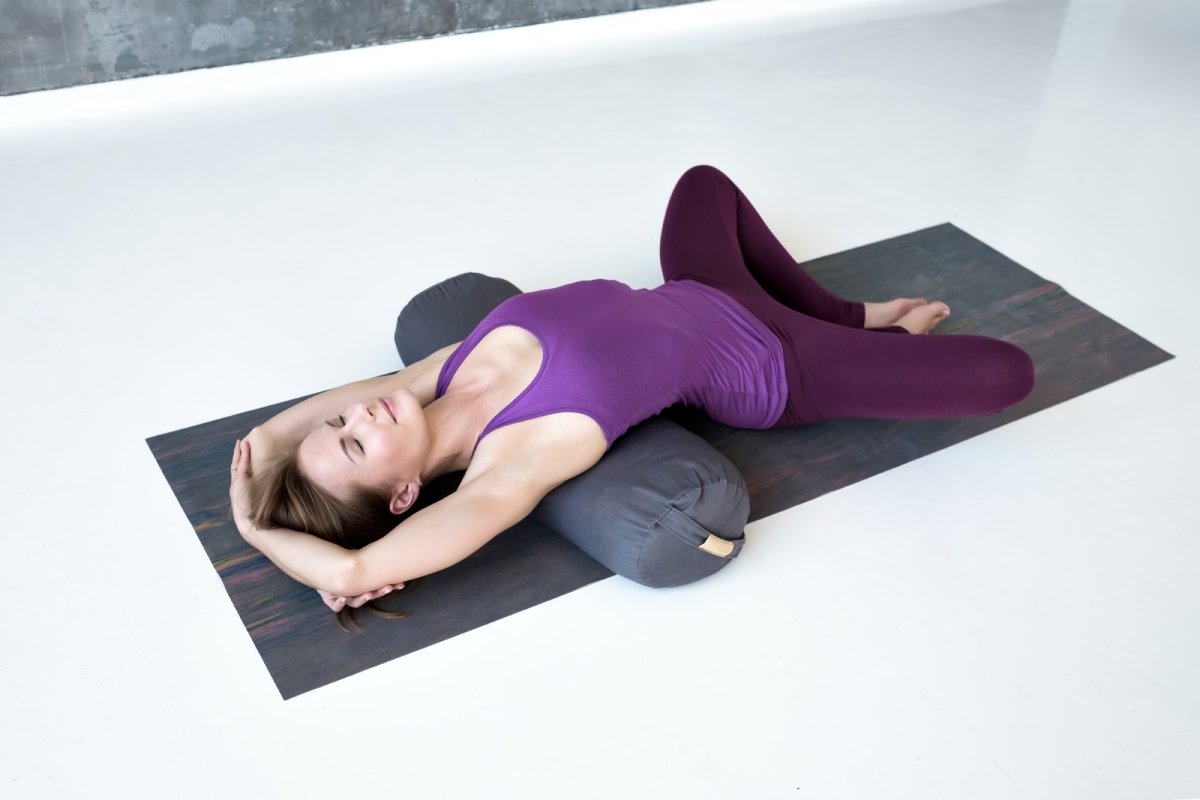Listen to this article:
Your yoga practice doesn’t always have to be an intense Vinyasa or Hot yoga workout. Some days, you just crave some restorative poses to release stress and relax tense muscles. A yoga bolster adds the cushion and support you need to fully melt into those postures while taking the pressure off your lower back or joint.
This simple prop is a staple in every yoga studio thanks to its versatility on the mat. Whether you use it to support heart-opening poses, deepen your stretches, or lessen the strain on your spine, using a yoga bolster is simple and feels oh-so-nice.
Here are our favorite yoga bolster poses and how to do them.
Contents
- 1 What is a Yoga Bolster?
- 2 Best Yoga Bolsters
- 3 9 Restorative Yoga Poses with a Yoga Bolster
- 3.1 Bolster Hero Pose (Virasana)
- 3.2 Supported Reclined Bound Angle Pose (Supta Baddha Konasana)
- 3.3 Supported Pigeon Pose (Kapotasana)
- 3.4 Wide Angle Seated Forward Bend (Upavistha Konasana)
- 3.5 Supported Fish Pose (Matsyasana)
- 3.6 Supported Backbend
- 3.7 Legs Up the Wall Pose
- 3.8 Low Lunge with Bolster (Anjaneyasana)
- 3.9 Supported Knee Twist
- 4 FAQs
- 5 Closing Thoughts
What is a Yoga Bolster?
A yoga bolster is a firm pillow or cushion designed to support certain you in yoga poses. Bolsters come in a variety of shapes and sizes, from rectangular to round, thin or thick, and natural or synthetic materials.
Bolsters are very popular in Yin yoga, pregnant yoga, and restorative yoga classes where added cushion can deepen the stretch without straining joints or bones. They also add height and support to open the heart or the hip flexors.
Sometimes your mat just isn’t quite enough. A yoga bolster adds that extra buffer between you and the floor for maximum comfort and rejuvenating relief.
Best Yoga Bolsters
- YOGA BOLSTER: Get some added support with the Manduka Rectangular Bolster. Supports the body during yoga, meditation, or fitness practice. Manduka’s eQua micro-fiber cover has a plush, suede-like feel and is fully removable
- EFFECTIVE COMFORT: Our firm soft to the touch microfiber cushion provides superior support and cushioning to your daily yoga practice. Absorbent, plush fabric cover keeps you dry, supported, and comfortable-- No matter where your workout takes you
Our favorite yoga bolsters are the Manduka Enlight Rectangular Bolster, Brentwood Home Crystal Cove Yoga Bolster, and Gaiam Sol Studio Round Yoga Bolster. Each of these bolsters offers maximum comfort and dense, yet plush support with the added bonus of being aesthetically pleasing in your home.
For a deep dive into the best bolsters available online, check out our full review of the Top 8 Yoga Bolsters.
9 Restorative Yoga Poses with a Yoga Bolster
Restorative yoga is the most restful, muscle-melting yoga style out there. With a bolster, your comfort and meditative bliss can go to the next level.
Bolster Hero Pose (Virasana)
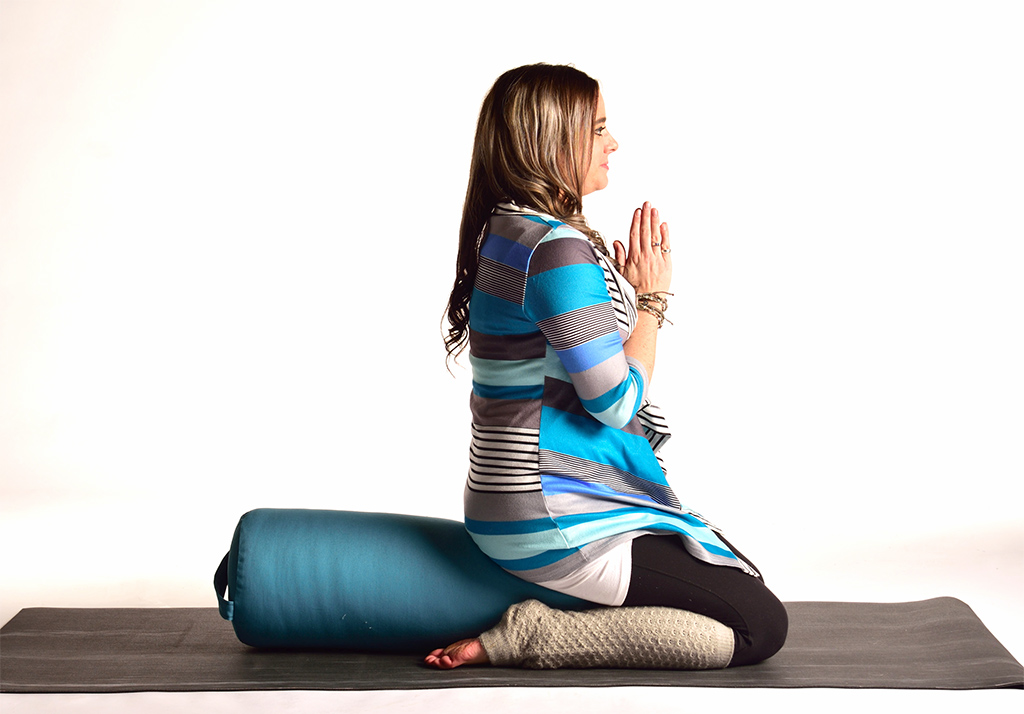
Hero pose can be difficult for many people due to the internal rotation of the thighs and hips. Adding a bolster makes it so much easier to sit between your heels and still enjoy the quadricep stretch, lumbar strengthening, and low back release.
Begin on the tabletop with your knees about hip-width apart. Place a bolster lengthwise between your legs, bend your knees more, and sit back on it under your tail bone. If this is uncomfortable for your joints, place a folded blanket underneath your knees for added cushion.
Allow your knees and calves to hug the bolster as the tops of your feet rest on the floor. Your pelvis will be tilted slightly forward and your back straight. Feel your quads and thighs lengthen. Breathe and settle your hips downward.
Supported Reclined Bound Angle Pose (Supta Baddha Konasana)
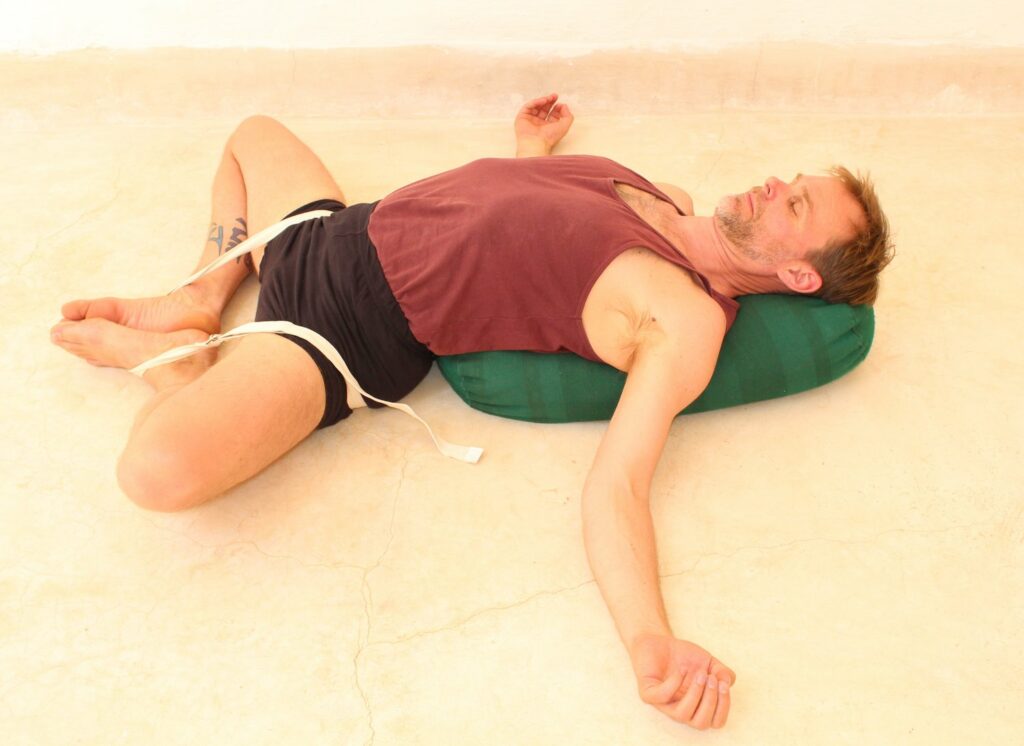
For an even deeper relaxation, you can find this reclined resting pose to soothe your nervous system, lower your heart rate, and help relieve anxiety.
From Hero Pose, take and deep breath and exhale to lay back over the bolster into Reclining Hero Pose (Supta Virasana). If this causes any discomfort, you can use a block beneath the bolster to add extra height.
Adjust the soles of your feet to press together and allow your knees to drop open to each side like a butterfly. Shift your tailbone from side to side until your spine lengthens along the bolster. Your elbows can lay open to your side with palms up. Feel your hip flexors and lower back fully release as you breathe and let your body melt into the bolster.
Supported Pigeon Pose (Kapotasana)
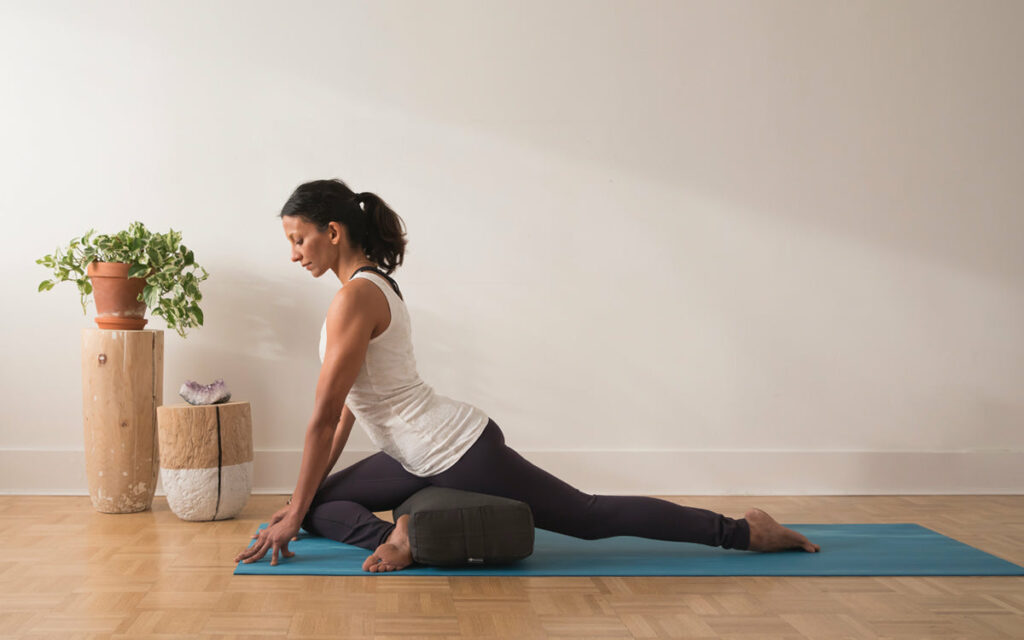
Pigeon Pose can be pretty intense for anyone with tight hip flexors or sore glutes. This deep hip opening pose counteracts the effects of sitting at a desk all day or challenging yourself in a run. This pose can even be painful due to the external rotation of the thigh and tension on low back. A bolster can fix the problem right away.
Begin in a Downward Dog. Lift one leg and inhale to lean forward and bring the leg under your chest, folding the knee outward and your foot across toward the opposite hip.
Place the bolster perpendicular to your body and adjust it under your hips. Your externally rotated bent knee will be elevated as your glute rests on the pillow. This base will lessen the strain on your knee and hip flexor while still allowing you to fully open up to the lower body stretch.
Wide Angle Seated Forward Bend (Upavistha Konasana)
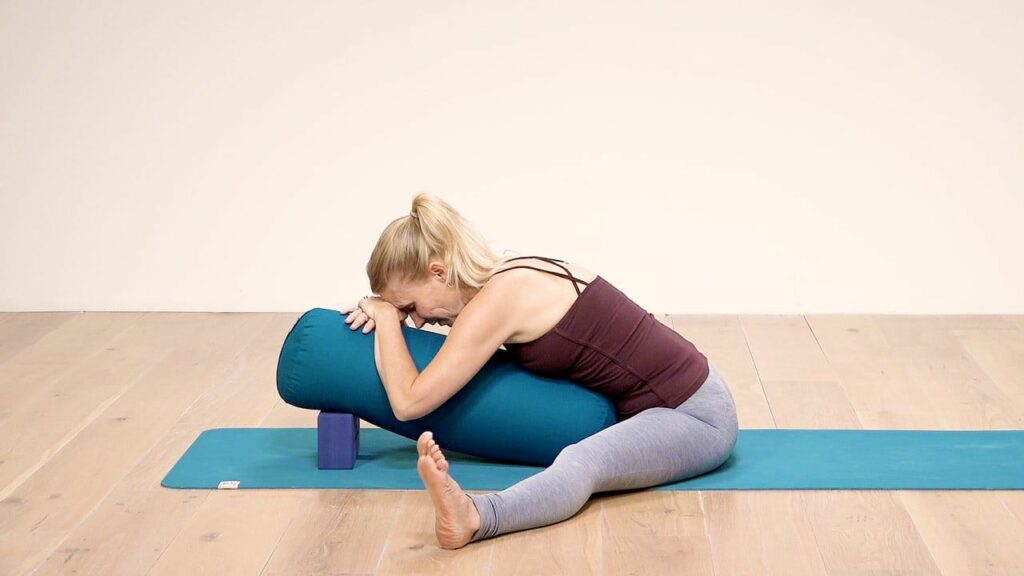
Wide Angle Seated Forward Bend is another deep hip opener that is difficult for anyone with reduced flexibility. Instead of curving the spine and forcing the body into misalignment, you can use a bolster to fully relax in the pose while staying lengthened.
Begin in a seated position with your legs extended out in front. Adjust your body so you are directly on top of your sit bones. Widen your legs out to the side as far as is comfortable. Flex your feet and point the toes up toward the ceiling.
Place a bolster lengthwise between your legs, with the short edge up against your groin. If desired, elevate the other end of the bolster with a yoga block.
Inhale and thoroughly lengthen the spine. It is important not to hunch here. Exhale and hinge at the hips, reaching forward with your hands as you melt your torso over the bolster between your legs. Don’t worry if you can’t go very far; as long as you avoid curving the spine, you are enjoying all the hip-opening benefits of this pose. Lengthen and relax.
Supported Fish Pose (Matsyasana)
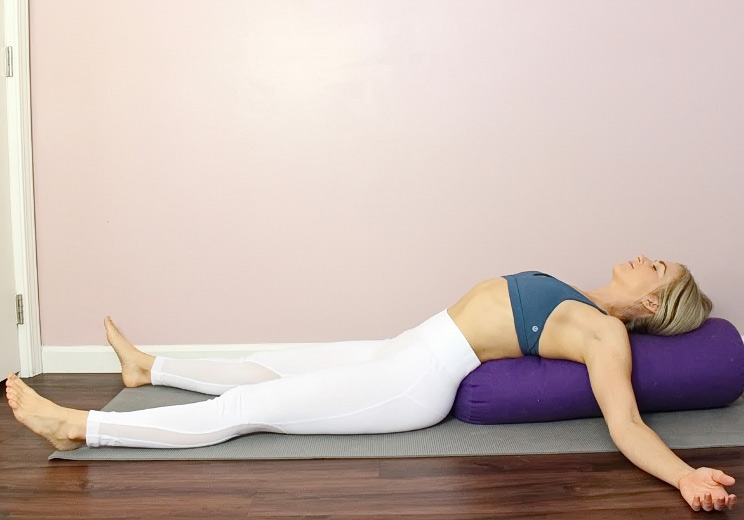
If you have chest or shoulder pain, heart-opening poses can help loosen up your upper body and reverse the damage of poor posture.
Begin with bolster lengthwise near the top of your mat. Sit in front of the bolster with your legs extended and begin to slowly lean back onto the cushion with your hips remaining on the ground.
As your upper body and chest open toward the ceiling, extend your arms straight out to the sides with palms up. All your shoulder blades to melt over the bolster. Keep the feet relaxed and lightly splayed out the side. Fully release and stay for 10-20 breaths.
Supported Backbend
Legs Up the Wall Pose
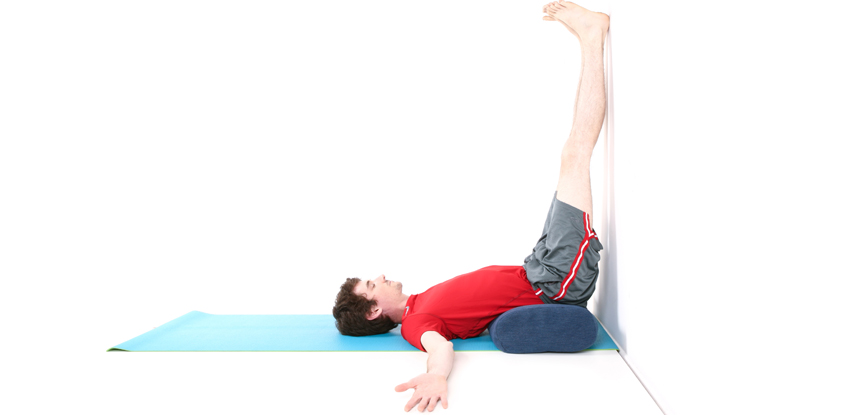
This simple asana is the ultimate low back pain relief. Start sitting with your right side toward a wall. Turn and swing your legs upward and lift your body to place the bolster under your sacrum. Move your hips a little closer to the wall as you lay down flat on your back.
Extend your legs upward with heels touching the wall. Allow your head and upper body to sink as your lower back and glutes melt into the bolster. Hold for 1-3 minutes as you breathe deeply.
This light inversion gently stretches your hamstrings and releases your neck while providing sciatica pain relief. It is known to increase energy, help with migraines, improve digestion, and promote lymph flow.
Low Lunge with Bolster (Anjaneyasana)
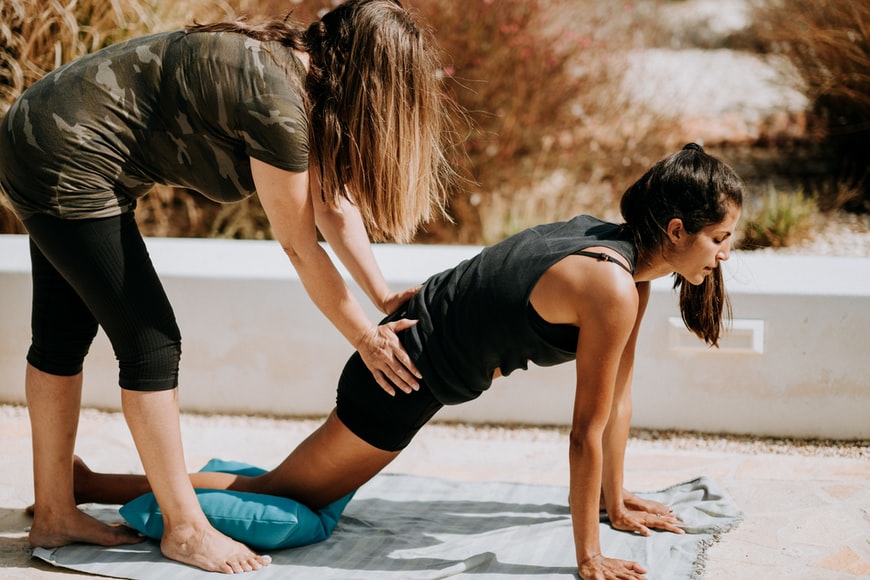
Knee pain can be a major source of discomfort in yoga. But that doesn’t mean you can’t enjoy deep stretches through your inner thighs in low lunge. Simply placing a bolster or yoga pillow under the back knee gives additional support and makes this pose feel soothing rather than painful.
Begin in a tabletop position with knees bent about hip-width apart. Place a bolster horizontally under your knees. Inhale and bring your left leg forward to the outside of your left arm. Lunge into your right leg as your hip flexors open and the right knee rests on the yoga pillow. Keep the spine straight and take a few breaths. Repeat on the opposite side whenever you are ready.
Supported Knee Twist
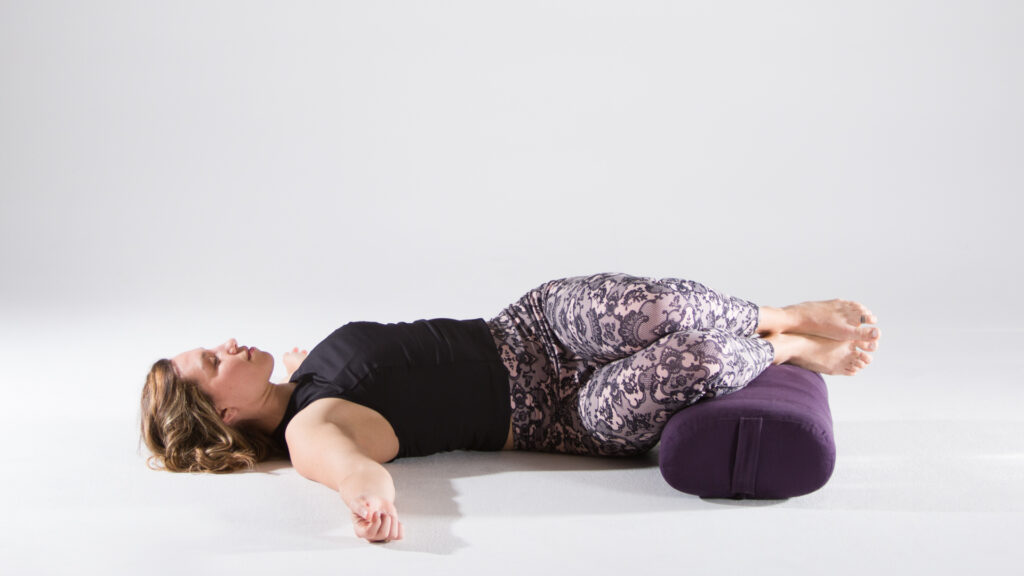
As one of the best Yin Yoga postures for low back pain, a Supported Knee Twist can improve spinal flexibility, digestion, and reduce stress. If this pose feels uncomfortable on your tail bone or hips, try placing a bolster beneath the knees to add support and elevation.
Begin laying flat in Savasana with a bolster beneath your knees. Bend your knees slightly and use your hand to guide your left leg on top of the right.
Slowly rotate the top leg and both knees over to the side as your spine stays reaching toward the ground. Extend your shoulders and arms out to the sides in a T shape with palms up, breathing into the light lower spinal twist.
FAQs
Is a yoga bolster necessary?
For anyone with knee pain, back pain, or reduced flexibility, a yoga bolster can transform your practice by adding height, support, and cushion. They soften postures while helping you maintain alignment. These unique yoga props are more than just a firm pillow; they are specifically designed to elevate and support in a wide variety of asanas.
What is a yoga bolster used for?
In restorative or yin yoga postures, a yoga bolster profoundly deepens your capacity to fully relax in your yoga practice. They support the back in heart-opening poses or cradle the knee in poses that may otherwise be challenging on the joints. Bolsters help people who have reduced flexibility or mobility. They also soften postures to help your body fully open and release.
Closing Thoughts
As a yoga teacher, I really think that a yoga bolster is one of the most underrated yoga props in the studio. It is so much more than just a firm pillow; it is the perfect supportive complement to restorative poses. It can be used as a cozier block replacement or in conjunction with yoga blocks.
Yoga teachers all over the world have recommended the use of bolsters for thousands of years. If you’re looking for deep relaxation, more comfortable asanas, and a little less firmness against the floor or mat, these yoga pillows are definitely worth the investment.


